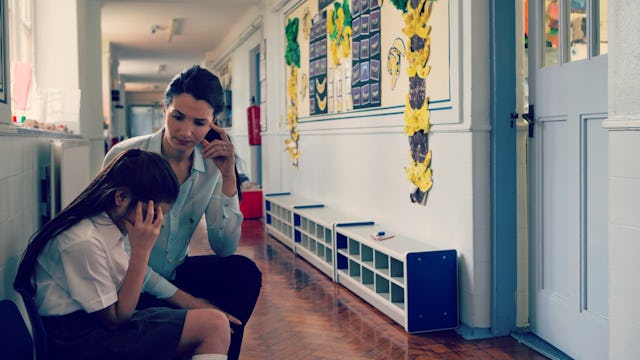'The Cost Of Caring': Teachers Suffer When Their Students Suffer

For the sake of privacy, I am not allowed to know most things about my husband’s job. What I do know: We buy a lot of granola bars. My husband keeps them in his classroom for kids who are hungry. Not “I need a snack because I’m growing” hungry, but the kind of hungry that gnaws at your bones, the kind that follows missed meal after missed meal.
I was so upset to find he had hungry kids in his classroom. I spun huge plans to feed them all. But he wasn’t allowed. He couldn’t do it. The granola bars were all he could do — and yes, people knew the kids were hungry. That’s why the school served breakfast. But some kids couldn’t make it because they were responsible for dropping off younger siblings.
When we think of the work of teaching, we think of standing in front of a classroom, of lecturing and grading tests. We don’t think of the emotional side. And we certainly don’t think of vicarious trauma — something that can be caused by “repeatedly hearing horrible stories about extremely stressful events,” according to a report from A Publication of the National Register of Health Service Providers in Psychology. One anonymous teacher says, “Every year you’re going to have students who are not performing the way they should because of terrible events you have no control over. All you can do is be an open ear, call law enforcement if that hasn’t already happened, and bring food.”
Edutopia notes that more than half of U.S. kids have been traumatized by abuse, neglect, violence, or “challenging household circumstances,” and the CDC says that 35% of kids have “experienced more than one type of traumatic event.”
These are the kids who fill our classrooms — my husband’s classroom — every morning. A teacher can serve as a caring, non-family adult in which a kid can confide, maybe the only one a kid has. In “The Consequences of Reporting Child Maltreatment: Are School Personnel at Risk for Secondary Traumatic Stress?” one teacher describes having a 6-year-old report sexual abuse by her mother’s boyfriend: “At work, I think about it all the time. I think about her fairly often. What happened to her? […] I wonder about that little girl … she had all the signs, all the signs I didn’t recognize then, but now I know.” Years after the event, she experiences recurring thoughts about the little girl.
Edutopia reports that, according to the American Counseling Association, “sometimes called the ‘cost of caring,’ vicarious trauma can result from ‘hearing [people’s] trauma stories and becom[ing] witnesses to the pain, fear, and terror that trauma survivors have endured.'”
This is compounded by mandated reporter laws, which state that teachers are obligated to report signs of child abuse: sexual, physical, emotional, or general neglect. So if a student looks like they’ve been hurt, the teacher needs to initiate conversation. Education professional Kit Richert recommends an approach like, “So, tell me about those bruises.” So in my husband’s case, for example, you’d end up saying things like, “I notice you’re taking a lot of granola bars. When’s the last time someone cooked dinner?” Then, worst of all, you have to look into the eyes of a kid you like, a kid you’ve gotten attached to, a kid you might be proud of for mastering some Shakespeare or learning algebra, and hear what he or she has to say. And it just might break your heart.
According to Edutopia, LeAnn Keck, a manager at TraumaSmart, says, “It seems like teachers have in some ways become case workers. They get to know about their students’ lives and the needs of their families, and with that can come secondary trauma.” And this manifests itself the same way primary trauma does. The brain releases cortisol and adrenaline, which can “increase heart rate, blood pressure, and respiration, and release a flood of emotions.”
Teachers can show mental and physical symptoms, including anger or headaches and missing meetings, lateness, or avoiding certain students. The National Register of Health Service Providers in Psychology names several common symptoms of vicarious trauma including intrusive images, nightmares, emotional numbing, dissociative experiences, and exaggerated startle response. They note that “they also may include changes in how the individual experiences him/herself and others, such as changes in feelings of safety, increased cynicism, and disconnection from loved ones.” It can cause depression, and contribute to drug or alcohol abuse.
But there are some ways to help.
Edutopia recommends talking it out; Micere Keels, founder of a trauma-informed curriculum for urban teachers, says that connecting with other teachers to “talk through” the experiences “can be invaluable for teachers coping with secondary trauma.” It can also help to anticipate stressful situations and develop coping strategies for them in advance. If, for example, you know your students get antsy a few minutes before the bell, work that into your teaching routine. You also need to leave work at work, so develop coming-home rituals, even something as simple as switching off your work phone.
My husband, for example, always calls me from the car on his way home from work. It helps him decompress and prepares him for coming home to his own children.
Teachers in our society carry a heavy burden, and that burden is only getting heavier. As we pile standardized test upon standardized test, demand more “accountability” in the form of, well, forms, we sap educators of the energy they need to do this kind of serious emotional work. These administrative requirements erode their psychic energy, leaving them with little to draw on when these traumatic situations arise.
We need, in other words, a greater awareness of vicarious trauma in teachers and school-wide programs to combat it. Only then will people stop leaving the profession in droves and will good teachers stop suffering burnout — or worse.
This article was originally published on